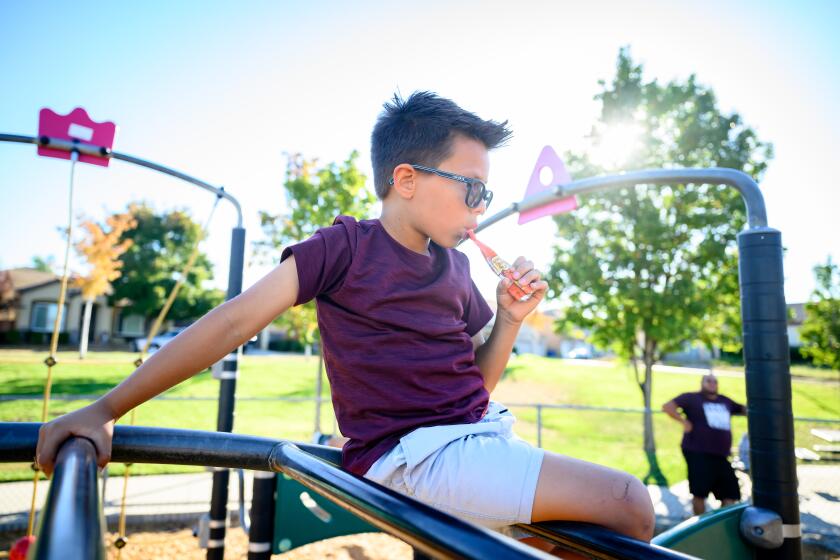Jason Not Among Fortunate Majority of Heart Recipients : Medicine: The survival rate for children who have such transplants is 72% worldwide. The number of donors is not keeping pace with the demand, however.
If it were merely a matter of odds, Jason Jenette probably would have lived after receiving a heart transplant.
Since 1985, about 1,600 children worldwide have received donated hearts, and the survival rate is 72%. The procedure has become so common and generally successful that the supply of hearts is falling further behind the demand.
“The survival (rate) continues to improve, but as transplants are offered to more and more patients, there is a serious lack of donors,” said Dr. Vincent Zales, medical director of the transplant program at Childrens Memorial Hospital at Northwestern University Medical School in Chicago.
But Jason, a 2-year-old boy born with a hole in his heart, wasn’t among the fortunate majority.
He died at the Loma Linda University Medical Center on Thursday, five days after receiving a donated heart and despite a dramatic effort to save him by medical teams from Loma Linda and Children’s Hospital of Orange County.
Jason was the exception rather than the rule.
When Eddie Anguiano was 4 days old, he became a pioneer, the first child in the world under the age of 1 to have a heart transplant. The landmark event in medical history occurred in November, 1985, at Loma Linda Medical Center.
The surgery was a life saver, and now the 7-year-old likes to run and play. “He is just everywhere, he never gets tired,” said his mother, Maria, who lives with her son in Fontana.
She has been amazed by the X-rays of his heart, as it grows along with him. “It looked like a walnut and now it looks like a big old pear. It’s beautiful,” she said.
The Registry of the International Society for Heart and Lung Transplantation reports that more than 1,600 children have received heart transplants and 72% have survived. Their chances of survival are as good as for adults.
Because of the successes and the increasing number of medical centers able to do the surgery, many more children are getting heart transplants.
National registry figures show that 169 children up to 5 years of age had heart transplants in the United States in 1991, the last year for which figures are available, contrasted with 59 in 1988. Also, the number of individuals between 6 and 18 receiving new hearts gradually increased from 69 in 1988 to 85 in 1991.
But the supply of donors is not keeping up with demand, meaning that some children are waiting much longer and more are dying before compatible hearts can be found.
Zales said the time children must wait for donor hearts has doubled in the Midwestern states in the last two to three years. “The waiting period for newborns used to be less than a month and now it is at least two months,” he said.
The same heart shortage exists in the West, said Dr. Bruce Reitz, chairman of the pediatric cardiac transplant program at Stanford University. “Some patients can get real lucky and it will be a week or 10 days (to get a heart), but for some it will be as much as three or four months.”
Physicians say they try to keep young patients with weak hearts alive with drugs or respirators or, as a last resort, with heart-lung machines.
However, cardiac physicians stress that extensive time on the heart-lung machines, combined with blood thinners given to patients, can create the same problems that Jason Jenette experienced--including lung congestion and brain hemorrhaging. The hemorrhaging is believed to have caused his death.
Zales said a few years ago, 10% to 20% of the youngsters waiting for heart transplants at the Chicago medical center died before a heart became available, contrasted with between 30% and 40% today.
The United Network for Organ Sharing, a Virginia-based organization that tracks heart donor and recipient statistics for the federal government, reports that 68 children are waiting for hearts throughout the nation.
A spokesman for the organization said that obtaining children’s hearts is even more difficult than obtaining the hearts of adults because consent must be obtained from grief-stricken parents.
“It seems such a waste for an infant to die for lack of a heart,” said Dr. Marti Baum, a pediatrician who treats children after they’ve received heart transplants at Loma Linda University Medical Center.
Baum said that because children who have heart transplants must continue taking drugs to prevent their bodies from rejecting the foreign organs, they will be at greater risk through life for infection and illness.
Also, she said in some cases children with transplanted hearts may have some learning disabilities, apparently as a result of oxygen loss to the brain during the operation or while on heart-lung machines. Eddie Anguiano, for instance, has a speech impediment and takes special education classes.
But she said that 90% of the babies who have had heart transplants will enjoy normal growth and development. “A good number of them are smaller than normal (when they get new hearts), but they start to catch up and by the time they are 3 to 7 they are doing just fine.”



